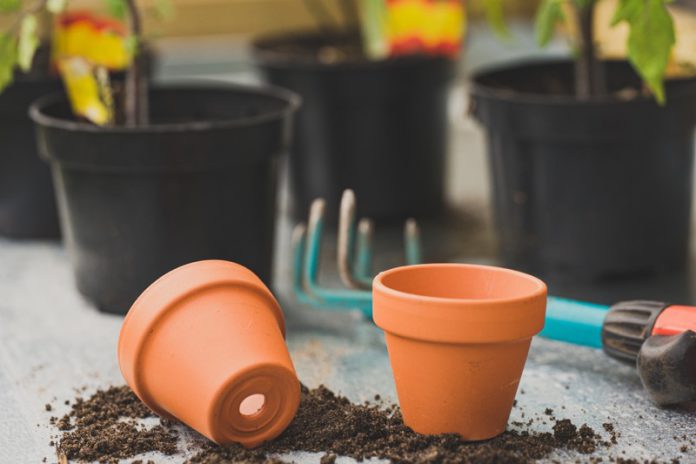A container garden can be a great and simple way to enhance your landscaping, especially if you live by a lake. It can add a splash of colour to your porch, patio, entryway or pier and allow you to experiment with different plants.
For those who own vacation homes, container gardens are often easier to maintain than a large, in-ground garden, as it frees up more time for relaxation instead of tending to weeds.
Why are container gardens more manageable than in-ground gardens?
First, let’s explore the various reasons why using containers and boxes can be easier than traditional gardening.
Container gardens offer improved accessibility
Taking care of plants in containers can be physically easier than tending to in-ground gardens because you can position the containers at a more comfortable and workable height.
This allows you to care for your plants while standing or sitting without bending over or kneeling, which can strain your body.
Containers are also a fantastic option for individuals who lack access to a plot of land but still want to care for plants. They can be placed on balconies, decks, or concrete pads, allowing for easy and accessible gardening.
They are more flexible
Maintaining a small garden plot for seasonal lake homeowners can be challenging, so container gardens are an ideal solution.
With container gardens, you can enjoy the benefits of a seasonal garden without worrying about weeds taking over when you leave for the winter.
Cleanup is easy if your plants don’t survive – just empty the container.
Growing plants and vegetables in containers also offer the advantage of portability. Seasonal lake house residents can take their favourite plants when they leave.
Great for beginners
If you lack gardening experience, containers are an excellent starting point. Their size makes them manageable and easier to grow compared to maintaining a garden plot, as there is no need for digging or tilling or using too many specialised tools.
You also have significant control over growth factors such as water, sunlight, soil type, and nutrients.
How to pick the perfect pot or container?
Regarding aesthetic container gardening, various containers are available, including plastic, wood, clay, concrete, and fibreglass.
While many of these can get the job done, choosing the right container for a lakeside setting requires more thought.
Most lakeside property owners opt for clay and untreated wood pots because they offer a natural look and better plant protection. These pots regulate soil temperature more effectively than plastic or fibreglass ones and evaporate water through their walls better.
However, there are downsides to these pots. Clay pots can break easily or freeze at low temperatures, while wood is prone to rot and decomposition in high moisture environments. Consider the pros and cons of each and choose the option that works best for you.
If you have a plot of land, consider a larger container accommodating mature plant roots. Consult your local garden centre for expert advice on the most suitable type of container for your needs.
Before purchasing containers for your plants, inquire about the root systems of the plants you plan to grow. It’s essential to select containers that will accommodate the roots of mature plants. For instance, tomato plants require a depth of two feet, while zinnias only need a few inches.
Larger containers may be better in areas prone to drought conditions (such as waterfront locations), as they can store more water and nutrients your plants need.
Flowers that are suitable for dock planters
If your lakefront landscape gets a lot of sunlight, it’s advisable to plant only one type of plant per flower pot. This provides ample space for plants to grow and multiply, offers greater design flexibility, and creates a more natural look.
However, when planting different items in the same pot, you must consider their peak bloom times, height, colour, and compatibility when planted close together.
You can plant the following flowers along your lakefront landscape:
- Petunias;
- Pansies;
- Violas;
- Hydrangeas;
- Calibrachoas;
- Geraniums;
- Marigolds;
Create an edible container garden
Why not take your dockside container garden to the next level by planting some containers with edible produce that looks not only good but also tastes delicious? It is better to use a larger container for container vegetables.
Several produce plants are perfect for planting and thriving in containers, including:
- Tomatoes;
- Cucumbers;
- Sweet and chilli peppers;
- Squash;
Herbs are also amazing plants for container gardens that do double duty to provide beauty and food. It would be ideal for growing herbs in an area with lots of sun and moderate temperatures.
The following herbs do well in containers:
- Chives;
- Basil;
- Dill;
- Cilantro;
- Garlic;
- Fennel;
- Lemon balm;
- Mint;
- Marjoram;
- Parsley;
- Rosemary;
How to care for your container gardens
When you have established your container garden in a waterfront area, preserving its beauty can be challenging. The sun’s rays are intensified by water, so making sure your plants get enough water is essential. It is advisable to water your plants in the morning to help them withstand the heat of the day.
Avoid watering the foliage, which may lead to evaporation before the plant can use the water. It’s better to use a hose or watering can that allows water to flow directly into the soil. Wet foliage, caused by overwatering, rain, or insufficient air circulation, invents fungus and rot.
Keep the water flowing until the drainage hole begins to overflow, indicating that your container is soaked. Plants in a waterfront setting must be watered daily or every other day, particularly those exposed to the full sun.
If you’re going to be away, arrange for someone to care for your plants or consider using self-watering containers, drip irrigation systems, or probes attached to a water source. A thick layer of mulch surrounding the base of your plants can also aid in moisture retention.
In addition to watering, it’s essential to feed your plants with liquid fertiliser at least twice a month. Supporting larger or upward-growing plants with a trellis or stake can help them grow effectively.
To encourage growth and abundant flowering, it’s also important to regularly deadhead your plants.
Final thoughts:
Container gardening at your lake home can be a fun and rewarding way to beautify and refresh your outdoor space while enjoying fresh produce and colourful blooms.
With the tips and tricks outlined in this post, you can create a thriving container garden that will enhance the natural beauty of your waterfront property.
Whether you’re a seasoned gardener or a beginner, there’s no better time to start. So, what are you waiting for?
Start planning your container garden today, and don’t forget, if you want to ensure your garden looks its best all season long, book a professional garden maintenance service. A team of experts will take care of everything, so you can sit back, relax, and enjoy your stunning lakeside oasis.




